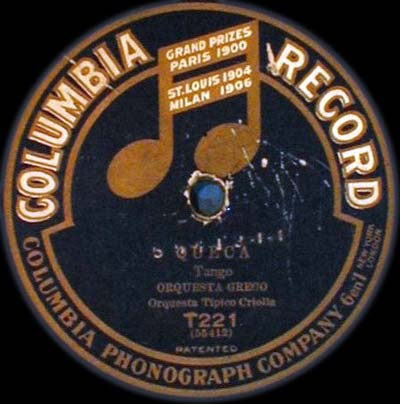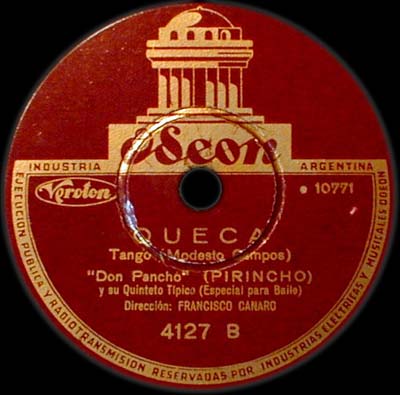By
Queca - “Queca”, a tango and two musician lovers

n 2010 when the centennial of the first recordings of the Orquesta Típica Criolla Greco led by Vicente Greco was celebrated, among the 36 pieces exhibited for the tango fans, was the tango “Queca” composed by the violinist Modesto Ocampo.
 This composer of African descent, born in Uruguay, also passed on us a second tango: “Te amo con delirio” which enunciates and complements the feeling the author had for the addressee of the first tango. Both numbers were meant for dancing.
This composer of African descent, born in Uruguay, also passed on us a second tango: “Te amo con delirio” which enunciates and complements the feeling the author had for the addressee of the first tango. Both numbers were meant for dancing.
By the late nineteen century and the early twentieth century it was customary to call all the women named María Angélica with the nickname Queca. That would lead to think that possibly the addressee of that homage would be the female dancer of the Salón San Martín, also known as Rodríguez Peña, a venue that was frequented by the author in the evenings of Buenos Aires on Saturdays and Sundays by that time.
The man, who had settled in Buenos Aires, liked “El bajo” (a tough area of the city where there were many cabarets and cheap cafes) and nightlife. Because of his job at a photographic lab he had enough money in his pockets. That oriental tough guy with strong fists, who was also violinist and guitarist, was charmed and a few choreographic hugs were enough for stirring up his creation.
There was no explicit dedication in the edition of the sheetmusic, just the charcoal strokes of the drawing –his other great art vocation- outlining the face of the woman alluded in the title of his tango. The original sheetmusic has two sections and a trio.
Curiously, Vicente Greco also evidenced his sentimental situation towards María Angélica López when he composed “María Angélica”, a tango he wrote between 1910 and 1912. On the sheetmusic the following dedication is read: «To Miss María Angélica López». They, both, dedicated in his own way, in a few years’ time, a piece for the mythical dancer.

Greco recorded first “Queca” for Columbia Record, (ca.1909/1910), disc T-221, matrix 55412, side A, evidencing the profound personal affection for the Oriental violinist.
The names of the personnel of that early tango aggregation that succeeded in recording were not completely established yet, but according to Oscar Zucchi, they would be: Greco (leader and bandoneon), Francisco Canaro (violin), Domingo Greco (guitar) and Vicente Pecci (flute). Even though there are doubts as for the presence of Canaro and Pecci.
The tango “María Angélica” was recorded in 1913 when its composer with his Quinteto Criollo Garrote was recording for the Atlanta label. Curiously, it was released on the B side of the disc 177. The trio that included Vicente Loduca, Celestino Ferrer and Eduardo Monelos also recorded it that same year for the Pathé label (disc 1745, A side).
“Queca”, in the rendition by the Orquesta Greco, was one of the first tango recordings that became famous in Paris in the early second decade of the twentieth century, but with another title: “Loulou”.
The sheetmusic of the two tangos by Modesto Ocampo were published as piano scores by E. E. Prelat, Santa Fe 2837-2841 (1908/1909). Recordings of “Te amo con delirio” were not yet found.
There is a secong recording of “Queca” made by Francisco Canaro fronting his Quinteto Don Pancho (1940). It is an Odeon record which has a mistake in the last name of the composer. It appears Campos instead of Ocampo.
This brought legal and financial consequences and about that we read an ad in the upper section of page Nº 13 of the Revista Uruguay, a Montevidean publication of the black community, of February 1946 which says:
«From the International Service, special for the Revista Uruguay. Correspondent. Bs. Aires, February 1946. The Odeon house of Bs. Aires will pay an important sum to a composer of the community that lives in Argentina. He is Modesto Ocampo, a prestigious Uruguayan composer who has been based in the city of Buenos Aires for many years. Around 40 years ago the tango “QUECA” was played in Montevideo and Buenos Aires. By that time composers’ rights were only part of a generous expectation. Thereafter what at the beginning was a fine inspiration by our masterly composer, was carried to the paradise of art, but through means that legally are called misappropriation. Before the Buenos Aires courts the proceedings were followed that would end with a huge amount of money for the honorable member of our organization don Modesto Ocampo.»

That rendition of the Quinteto Don Pancho, which because it is updated shows interesting aspects, in its development it does not respect the existence of the two sections and the trio that comprise the original music. Regretfully, the second section is the one omitted, and the performance alternates between the first section and the trio. We must admit that due to its tango style performance, the piece all the same, successfully passed despite the missing portion. It can be perfectly followed with the first edition by Prelat, because it satisfactorily fits the musical creation presented. What is fair is fair. Imagine that performance had it played all the sections!
Finally, in 1954 Julio Korn published a second version of “Queca”, included in a group of sheetmusic copies of tangos of the Guardia Vieja. It was entitled: Álbum Nº 2 de 10 Tangos de gran suceso. There the three sections and the same number of bars are kept, placing the conclusion of the tango, in this edition, in the first section. In the original version by Prelat, that happened in the second section. In the melodic line some changes have been made but its identity equally was preserved.
It is a sort of arrangement for piano. The second section was given a crafty melody only for the violins, which when was played for the second time it is a little bit altered. As from the bar Nº 40, which takes place in the third section or trio, the traditional variation for the 1st and 2nd line of the bandoneons can be played. It turns out also new the addition of a text written by Héctor Polito and Antonio Polito seen on the page.